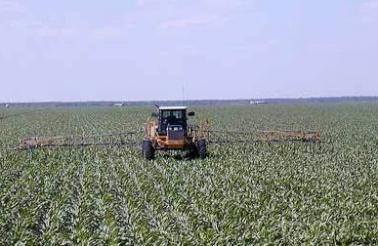
A recent scientific review and new study add to the mounting evidence that the chemical atrazine is harming animals and people far from the farms where the herbicide is used.
A review in the Journal of Steroid Biochemistry and Molecular Biology descr
ibes a litany reproductive damages to amphibians, fish, reptiles and mammals caused by the chemical herbicide atrazine.
A new study published in Environmental Research links atrazine to menstrual cycle disruptions in people in Illinois and Vermont, where drinking water is contaminated at levels previously considered safe.
Atrazine Contaminates Water Supplies in Farm Communities
Atrazine is the second-most widely used herbicide in the United States, at 75 million pounds of it applied annually to fields of corn and other crops, and is used in 60 other countries around the world. The chemical, long suspected in the decline of frog populations, is routinely found in groundwater and surface water – rivers lakes and streams – as well as rain.
A 2010 study by the Natural Resources Defense Council found atrazine in 80 percent of public water systems of the 153 sampled in the Midwest and Gulf States, where the Mississippi River carries agriculture pollution from the plains. The U.S. Geological Survey found atrazine in 75 percent of the stream water and 40 percent of the groundwater sampled in the same regions.
EPA Waiting for “Smoking Gun” Before Considering Ban?
Among the reproductive problems described in the new review in Journal of Steroid Biochemistry and Molecular Biology are the following:
changes to the expression of genes involved in hormone signaling;
interference with metamorphosis;
inhibition of key enzymes that control estrogen and androgen production;
and skewing of the sex ratio of wild and laboratory animals (toward female).
And just recently, a study in Envionmental Research linked drinking atrazine-contaminated tap water to menstrual disorders in women in Illinois and Vermont, even when the tap water in question had far less than the Environmental Protection Agency allowable level of 3 parts per billion. The manufacturer of the weed-killer argues that perhaps these women were just under stress, but this study is not the first to tie atrazine in drinking water to health issues in people. In 2009 a different study tied atrazine in drinking water to low birth weight in Indiana newborns.
Several years ago, NRDC and others began calling for a complete phase-out of atrazine use and at least one of the scientists involved in the study echoes the call for a ban:
“I hope this will stimulate policymakers to look at the totality of the data and ask very broad questions,” Tyrone Hayes, a professor of integrative biology at the University of California at Berkeley and lead author of the review, told Science Daily. “Do we want this stuff in our environment? Do we want — knowing what we know — our children to drink this stuff? I would think the answer would be no.”
Unfortunately, Tom Philipott of Mother Jones reports that EPA will “not even consider” a ban before 2013, which doesn’t mean they will ban it in 2013, but that they will think about it then.
What Can You Do to Protect Yourself from Atrazine?
If you live in a farming region, you can get involved in local and state efforts to reduce or eliminate atrazine without waiting for new federal regulations or a ban. You can request the water quality report from your local utility and urge your utility to step up monitoring of for atrazine to document the problem and then alert the public to the dangers. And, especially farming communities where atrazine has been found, you should to install and use home water filtration systems.
Courtesy of http://www.care2.com

